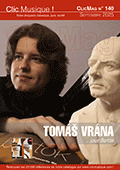 Le duo Schneiderman-Yamaya, connu pour un disque sur Adam Darr, virtuose de la guitare romantique allemande, nous propose ici des transcriptions et arrangements pour deux guitares de certaines œuvres du grand Beethoven. Tâche osée s’il en est, ces arrangements proviennent de divers compositeurs guitaristes de l’époque comme Carulli pour les variations et rondo op. 155 et fantaisie op. 157 pour piano, Schuster pour les variations op. 3 (septuor), l’andante op. 5 et les variations op. 4 extraits des quatuors n° 3 et 18, Klinger et Heeser pour un rondo pour violon et piano et quatre valses pour piano. Il n’est pas question de discuter la qualité technique irréprochable des guitaristes mais que penser de ces arrangements remaniés ? A l’évidence, la musique de Beethoven ne trouve pas d’écho à la guitare bien que lui-même appréciait l’instrument. Que ce soit au piano ou dans les magnifiques quatuors, summum de la musique beethovenienne, la marque du génie est sans cesse présente. Qu’en reste-t-il ici ? On ne reconnaît plus les lignes mélodiques, orphelines des nuances pianistiques si importantes dans les sonates par exemple. Sa musique géniale est diluée, simplifiée, et ramenée à une gentille mélodie de salon. Difficile d’adhérer à cet opus malgré la bonne volonté des interprètes. (Philippe Zanoly)  "Mein wohlfeilster Baron! sorgen sie, daß der guitarist noch heute zu mir komme… My humble Baron! Take care, that the guitarist still comes to me today…". So writes the 28 year-old Beethoven in 1798/9 in a note to his trusted friend Baron Nikolaus Zmeskall, imploring him to ask their friend Karl Friedrich Amenda to send singer/guitarist acquaintance Gottfried Heinrich Mylich to visit him. Among his earliest friends in newly arrived Vienna, Beethoven had both personal and professional relationships with guitarists including Raimund von Wetzlar (of whom he wrote ‘plays the guitar beautifully and with feeling’), Austrian government official and musicologist Raphael Georg Kiesewetter, Countess Maria Wilhelmine von Thun (dedicatee of Beethoven’s Piano Trio Op. 11, described as ‘one of our best guitarists’). Besides these affable friendships, Beethoven also pursued love interests with women who had connections to the guitar, including Antonie Brentano (accomplished amateur pianist and guitarist), Therese Malfatti (daughter of Beethoven’s physician whose sister was a guitarist and for whom Beethoven was to send a guitar part to a song), Countess Maria Carolina Anna von Thun (daughter of Maria Wilhelmine, and said to [excel] as a singer and guitarist’), and Regina Hitzelberger-Lang (‘A proficient guitarist and singer’). Despite, or maybe because of Beethoven’s acquaintance with casual guitarists, he did not compose for the guitar: perhaps his encroaching hearing loss did not enable him to value guitar performances, perhaps the instrument was not sonorous enough for his interests, or perhaps he did not cultivate the direct personal associations with professional players necessary to master an unfamiliar medium. His four compositions for mandolin and harpsichord of 1796 are a natural result of his experience with string writing prompted by personal patronage. Alongside informal awareness of the guitar, professional virtuoso performers also moved within Beethoven’s circle in immediate and indirect contact.
 |
